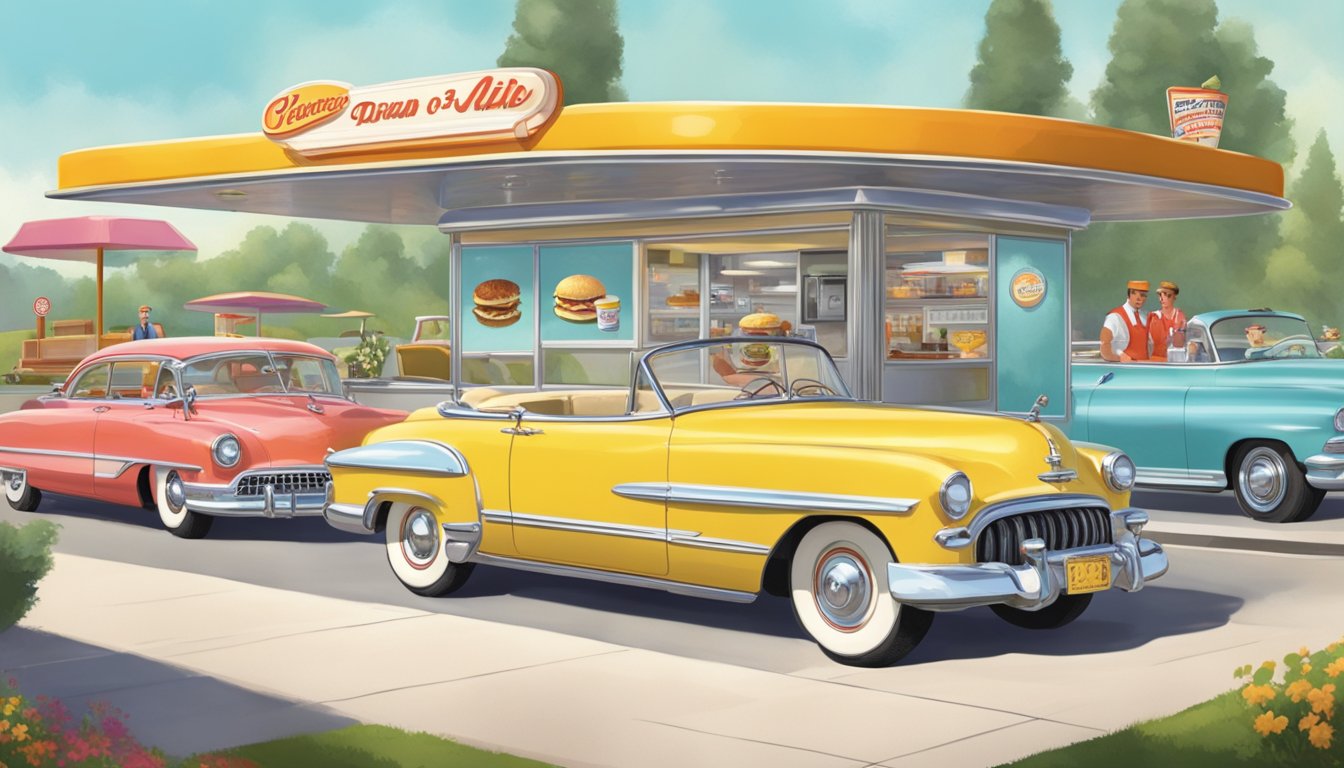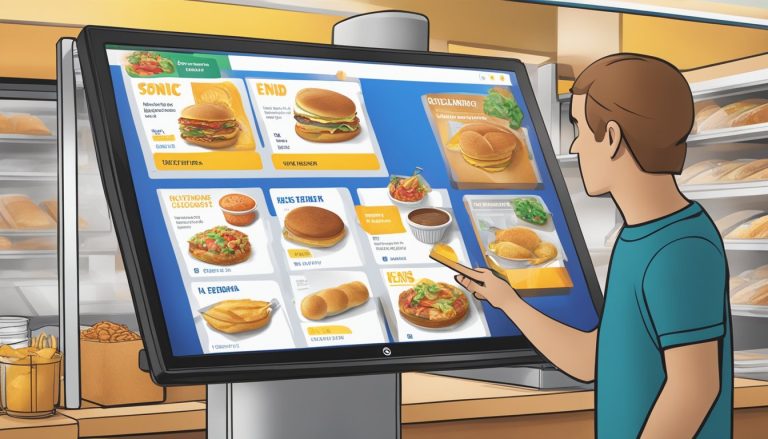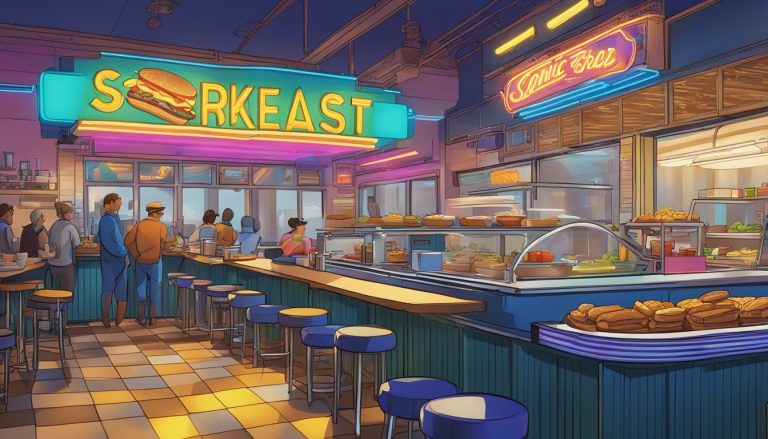Sonic Drive-In has carved out a unique niche in the fast-food breakfast landscape. Since its founding in 1953, the chain has maintained its iconic drive-in format while adapting to changing consumer preferences and technological advancements.
At Sonic, breakfast isn’t just a meal – it’s an experience. Customers can customize their breakfast orders, adding extra toppings or swapping ingredients to suit their tastes, all while enjoying the nostalgic charm of carhop service. This blend of personalization and retro appeal sets Sonic apart from other fast-food chains.
The evolution of Sonic’s breakfast offerings reflects broader shifts in the industry. While roller-skating carhops remain a beloved feature at many locations, the introduction of touchscreen menus represents Sonic’s commitment to innovation. This juxtaposition of old and new encapsulates the chain’s approach to breakfast: honoring tradition while embracing the future.
The History of Sonic Drive-In

Sonic Drive-In‘s story began in the 1950s, transforming from a small root beer stand into a nationwide fast-food chain. The company’s innovative drive-in model and unique carhop service set it apart in the competitive fast-food landscape.
The Founder Troy Smith and the First Root Beer Stand
Troy Smith, an Oklahoma native, started his entrepreneurial journey with a small root beer stand called Top Hat Drive-In in 1953. Located in Shawnee, Oklahoma, the stand quickly gained popularity among locals. Smith’s business acumen led him to experiment with new ideas to attract more customers.
He installed an intercom system, allowing customers to place orders from their cars. This novel approach proved successful, significantly boosting sales. Smith’s innovative spirit and commitment to customer service laid the foundation for what would become Sonic Drive-In.
The Transition from Service to Drive-In
In 1959, Smith and his business partner Charlie Pappe rebranded Top Hat as Sonic Drive-In. The name change was prompted by their slogan “Service at the Speed of Sound.” This transition marked a shift towards a full-fledged drive-in concept.
Sonic expanded its menu beyond root beer, offering burgers, fries, and other fast-food staples. The company’s growth accelerated through franchising, with new locations opening across Oklahoma and neighboring states. By the 1970s, Sonic had established itself as a regional fast-food powerhouse.
The Role of Carhops and Roller-Skating Service
Carhops became an integral part of Sonic’s identity, delivering food directly to customers’ cars. In the 1950s and 60s, many carhops began using roller skates to serve customers faster. This unique service style became a hallmark of the Sonic experience.
Roller-skating carhops added a touch of nostalgia and entertainment to the dining experience. They became so iconic that Sonic continues to feature them in marketing campaigns and even hosts annual skating competitions for employees.
The carhop service model allowed Sonic to maintain its classic drive-in feel while adapting to changing times. Today, many Sonic locations still offer carhop service, blending retro charm with modern convenience.
Evolution of the Breakfast Menu

Sonic’s breakfast menu has undergone significant changes since its inception, adapting to customer preferences and culinary trends. The drive-in chain has consistently innovated its morning offerings, introducing unique items that set it apart from competitors.
The Introduction of Breakfast Items
Sonic’s venture into breakfast began with a limited selection of morning staples. Early offerings included simple egg sandwiches and basic breakfast burritos. As demand grew, the menu expanded to include French Toast Sticks, a popular item that quickly became a customer favorite.
The chain recognized the importance of catering to on-the-go customers. This led to the development of portable breakfast options that could be easily consumed while driving. Sonic’s commitment to quick service and quality ingredients helped establish its reputation as a breakfast destination.
Expansion of the Breakfast Burritos and Sandwiches
Breakfast burritos became a cornerstone of Sonic’s morning menu. The Classic Breakfast Burrito, filled with eggs, cheese, and choice of meat, paved the way for more adventurous options. Sonic introduced variations like the SuperSONIC Breakfast Burrito, packed with tots, onions, and jalapeños.
Sandwich offerings also evolved. Sonic began using Texas Toast for its Breakfast Toasters, differentiating itself from competitors using English muffins or biscuits. These hearty sandwiches, featuring eggs, cheese, and various proteins, quickly gained popularity.
Menu innovation continued with the introduction of specialty items like the Breakfast Crunchwrap, blending Tex-Mex flavors with breakfast ingredients.
The Popularity of Toaster Sandwiches and Cinnasnacks
Toaster Sandwiches emerged as a unique Sonic breakfast item. The use of thick Texas Toast gave these sandwiches a distinct texture and flavor profile. Varieties like the Bacon Breakfast Toaster became customer favorites, offering a satisfying combination of crispy bacon, eggs, and melted cheese.
Cinnasnacks were introduced as a sweet option for breakfast or as a snack. These bite-sized cinnamon roll-inspired treats, served with cream cheese frosting, added variety to the menu. Their portability and shareable nature made them popular among customers looking for a quick morning indulgence.
Sonic’s breakfast menu continues to evolve, balancing classic favorites with new innovations to meet changing customer tastes.
Customization and Menu Offerings
Sonic’s breakfast menu stands out for its variety, quality ingredients, and personalization options. The chain caters to diverse tastes while maintaining a focus on flavor and freshness.
Developing Diverse Menu with Quality Ingredients
Sonic’s breakfast lineup features classic favorites and innovative creations. The menu includes hearty breakfast burritos, savory sandwiches, and sweet treats like French toast sticks. Each item is made with fresh, high-quality ingredients.
Eggs are cracked fresh for every order. Meats like bacon and sausage are cooked to perfection. Breads and buns are toasted on-site for optimal texture and taste.
Customers can customize their orders to suit dietary needs or preferences. Options include swapping meats, adding extra cheese, or removing certain ingredients.
Special Promotions and Limited-Time Offers
Sonic keeps its menu exciting with rotating specials and seasonal items. Limited-time offers introduce unique flavors and combinations to entice customers.
Past promotions have included:
- Maple Bacon Breakfast Sandwich
- Oreo Cheesecake Blast
- Green Mountain Coffee Iced Lattes
These promotions often coincide with holidays or seasons, like pumpkin-flavored items in fall. Sonic uses social media and targeted ads to generate buzz around new offerings.
Drink Selection and Drink Combinations
Sonic’s drink menu is a cornerstone of its customization strategy. The chain offers over 1.3 million drink combinations through its “Ultimate Drink Stop.”
Customers can mix and match:
- Sodas
- Slushes
- Fruit flavors
- Energy drink add-ins
Popular options include Cherry Limeade and Ocean Water. For breakfast, Sonic serves coffee, tea, and juice. Specialty coffee drinks like lattes and cold brews are also available.
The extensive drink selection allows customers to create unique pairings with their breakfast items. This level of customization sets Sonic apart from competitors in the fast-food breakfast market.
Customer Experience and Engagement

Sonic Drive-In has built its brand on creating a unique and memorable dining experience. The company combines nostalgic elements with modern conveniences to engage customers and foster loyalty.
The Importance of Carhop Service
Carhops remain a cornerstone of Sonic’s customer experience. These roller-skating servers deliver food directly to customers’ vehicles, adding a touch of nostalgia and personal service. This distinctive approach sets Sonic apart from other fast-food chains.
Carhops contribute to the restaurant’s retro ambiance while providing efficient service. They often develop relationships with regular customers, enhancing the overall dining experience.
Sonic has maintained this tradition while adapting to changing times. The company now offers a mix of classic carhop service and modern ordering methods to cater to diverse customer preferences.
Maintaining a Unique Dining Experience
Sonic’s drive-in model allows customers to enjoy their meals in the comfort of their own vehicles. This setup provides a sense of privacy and convenience not found in traditional fast-food restaurants.
The company offers a wide variety of customizable menu items, from burgers and hot dogs to unique drink combinations. This extensive selection caters to different tastes and dietary preferences.
Sonic’s signature items, such as cherry limeades and tots, contribute to its distinct identity. These menu staples evoke nostalgia for long-time customers while attracting new ones.
Utilizing Customer Feedback and Loyalty Programs
Sonic actively seeks customer input to improve its offerings and service. The company uses surveys, social media, and direct feedback to understand customer preferences and address concerns.
The Sonic app serves as a hub for customer engagement. It offers mobile ordering, exclusive deals, and a rewards program to incentivize repeat visits.
Sonic’s loyalty program, “My Sonic,” allows customers to earn points on purchases. These points can be redeemed for free menu items, encouraging customer retention and increasing visit frequency.
The company also engages in community initiatives and social responsibility efforts. These activities, such as supporting local schools, help build a positive brand image and foster customer loyalty.
Technological Advancements and Mobile Ordering

Sonic Drive-In has embraced technology to enhance customer experience and streamline operations. The introduction of digital tools has transformed how customers interact with the restaurant and place their orders.
Introduction of the Intercom System and Mobile Apps
Sonic’s iconic intercom system revolutionized the drive-in experience. Customers could place orders from their cars, adding convenience and efficiency to the process.
The introduction of mobile apps further modernized Sonic’s ordering system. These apps allow customers to browse menus, customize orders, and pay directly from their smartphones.
Mobile ordering has reduced wait times and improved order accuracy. Customers can now schedule pickup times, ensuring their food is fresh and ready upon arrival.
The Role of Technology in Enhancing Drive-Thru Service
Drive-thru service has significantly benefited from technological advancements. Digital menu boards provide clear, dynamic displays of menu items and promotions.
Automated order confirmation systems help reduce errors and improve communication between customers and staff. This technology ensures that orders are accurately recorded and prepared.
GPS-enabled apps allow Sonic to track customer arrival times, optimizing food preparation and delivery. This system minimizes wait times and ensures food quality.
Online Ordering and Its Impact on Sales
Online ordering platforms have expanded Sonic’s reach beyond traditional drive-in visits. Customers can now place orders from home or work for pickup or delivery.
This convenience has led to increased order frequency and higher average ticket sizes. Online ordering allows customers to take their time browsing menus and customizing items.
Data analytics from online orders provide valuable insights into customer preferences and trends. Sonic uses this information to refine menus, create targeted promotions, and improve overall service.
Integration with third-party delivery services has further boosted sales and expanded Sonic’s customer base. This partnership allows Sonic to reach customers who prefer the convenience of home delivery.
Advertising and Marketing Strategies
Sonic Drive-In has crafted a unique marketing approach that blends nostalgic elements with modern promotional tactics. The company’s strategies aim to attract customers by highlighting its distinctive drive-in experience and enticing menu offerings.
Leveraging Nostalgia and Retro Charm in Branding
Sonic’s marketing heavily emphasizes its 1950s-inspired drive-in format. The company showcases carhops on roller skates delivering food to parked cars, evoking a sense of Americana. This retro charm sets Sonic apart from competitors and appeals to customers seeking a unique dining experience.
The brand’s visual identity incorporates bold colors and vintage-style typography. These design choices reinforce Sonic’s connection to its roots while maintaining a contemporary feel.
Sonic’s advertisements often feature classic American cars and retro-styled uniforms. These visual cues tap into feelings of nostalgia, particularly among older customers who may have fond memories of similar establishments from their youth.
Innovative Happy Hour Promotions and Advertising Campaigns
Sonic’s “Happy Hour” promotion has become a cornerstone of its marketing strategy. Offering half-price drinks and slushes during specific hours drives traffic during traditionally slower periods. This promotion has proven highly effective in attracting cost-conscious consumers.
The company’s advertising campaigns frequently highlight its extensive drink menu and customizable options. Commercials showcase vibrant, colorful beverages to entice viewers and emphasize Sonic’s unique offerings.
Sonic has embraced digital marketing, utilizing social media platforms to engage customers. The brand runs interactive contests and encourages user-generated content, fostering a sense of community among its followers.
Recent campaigns have featured comedic actors in humorous situations, aiming to create memorable and shareable content. These lighthearted advertisements help maintain Sonic’s image as a fun, casual dining option.
Expanding the Sonic Brand

Sonic Drive-In leveraged franchising and strategic expansion to grow from a local Oklahoma burger stand into a nationwide fast-food powerhouse. This approach allowed rapid scaling while maintaining the brand’s unique identity and menu offerings.
The Strategy of Franchising and Brand Expansion
Sonic adopted franchising as a key growth strategy in the 1960s. This model enabled local entrepreneurs to open Sonic locations while adhering to the company’s standards and brand identity. Franchising allowed Sonic to expand rapidly without significant corporate investment.
The company provided franchisees with:
- Standardized restaurant designs
- Comprehensive training programs
- Marketing support
- Supply chain assistance
Sonic’s franchise agreements ensured consistency in food quality, service, and overall customer experience across locations. This approach helped maintain brand integrity while fueling growth.
Growth of Franchise Locations Across America
Sonic’s franchise-driven expansion led to significant growth across the United States. The company strategically targeted markets in the South and Midwest initially, before pushing into other regions.
Key milestones in Sonic’s expansion:
- 1960s: Expansion beyond Oklahoma
- 1970s: 1,000th location opened
- 2000s: Entry into Northern and Western states
- 2025: Over 3,500 locations in 44 states
Sonic adapted its menu to cater to regional tastes while maintaining core offerings. This flexibility helped the brand succeed in diverse markets across America.
The company’s expansion strategy focused on:
- Suburban and small-town locations
- Drive-in format with car-side service
- Customizable American fare menu
This approach allowed Sonic to carve out a unique niche in the competitive fast-food landscape.




